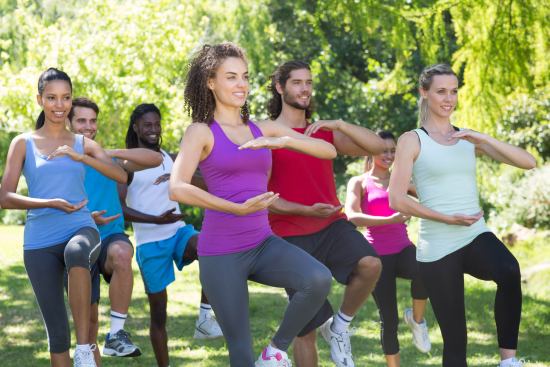People around the world practice tai chi for a variety of different reasons including defense and health effects, which may surprise you.
What is Tai Chi?
Tai chi is a defensive style of martial arts that includes gentle physical exercise and stretching and is known for its health benefits. Based on the philosophy of taiji, a balance between yin and yang, there are five different forms of this martial art. The movements of tai chi, which are often practiced in groups, tend to be slow and methodical. There are both physical and psychological benefits of this practice. It originated in China around the 12th century after which many other forms have geared up. While it was only found and practiced in China for hundreds of years, tai chi is now becoming a global phenomenon and is practiced across the world. [1]
Types of Tai Chi
The major types of tai chi include the Chen, Yang, Wu, and Hao families of discipline, as well as a combined form that draws from all the different families. [2]
Chen
This form involves a combination of both slow and very rapid movements, which makes it a difficult form to master, particularly for a beginner. That being said, this is also the first family of tai chi and is, therefore, one of the most popular.
Yang
Derived closely from the Chen style, this form of martial art is considered the most widely accessible and popular style in the world.

Learn to stretch your body with the calming tai chi. Photo Credit: Shutterstock
Hao
The least practiced and least well known, this style does not use many derived movements from the other three styles.
Wu
As the Yang came from the Chen, so too did the Wu come from the Yang, and this further derived style is even easier to practice for many people.
Combined
There are various forms of tai chi that combine one or more of the schools outlined above. Any combination is possible, so the forms are truly limitless.
Benefits of Tai Chi
The major benefits of tai chi include its effects improving heart health, treating arthritis, Parkinson’s disease, and chronic stress, and improving muscle strength, among others. It also improves balance control, fitness, and flexibility.
Treats Parkinson’s Disease
The reduction in stress and the neurological effects of this exercise have been linked to better flexibility and a slower progression of this disease. [3]
Relieves Depression
Tai chi is known to reduce stress hormones and help balance neurotransmitter levels, which can relieve symptoms of depression.
Flexibility
One of the main reasons people practice this martial art is to improve their flexibility. The controlled movements and the boost in muscle strength help people achieve this goal quite easily. [4]
Reduces Arthritis Pain
Through improving flexibility, blood flow and strength, regular practice of this martial art can help reduce symptoms of arthritis and joint pain. [5]
Improves Muscle Strength
This exercise is harder than many people believe and requires high control of the muscles. After only a few weeks of regular practice, you will notice a change in your muscle composition and control. [6]
Regulates Blood Pressure
Lowering stress levels and helping balance cardiovascular function, tai chi can also help lower blood pressure and decrease symptoms of hypertension. [7]
Relieves Stress
The calming effects of this exercise are known to reduce levels of stress hormones in the body, such as cortisol. This can help prevent inflammation and lower your risk of chronic diseases. [8]
How to do Tai Chi?
There are many ways to bring this martial art into your life, but there are also some good tips to help. For instance, you should start slowly, and wait to see how the practice affects your body. This can be a major calorie-burning exercise, despite the slow nature of the activity, and many of the movements and muscle groups you will be taxing are not used to that type of activity.
You should also dress appropriately for your session, and for beginners, the best options are loose and flowing clothing that allows for a full range of movement. Once you become more seasoned, you can practice tai chi once a day or more. Some practitioners spend hours each day slowly going through the movements, centering themselves and clearing their mind. A few other excellent tips can be found below.
Balancing
One of the key components of tai chi is a proper balance; many of the moves will be testing your body’s ability to remain in one place. Concentrate hard on maintaining your form without wavering, concentration on every part of your body at the same time. [9]
Rooting
This technique consists of imagining yourself rooted to the ground, unable to waver or fall. It is a mental trick that works surprisingly well.
Mental Focus
This martial art is impossible if you are not mentally focused and tuned in to your body. It will also help you clear your mind and focus on nothing but the movements and your balance.
Breathing
The other core aspect of tai chi is breathing. Ensuring that your body has the essential nutrient – air – throughout the entire session.
Precautions Before Practicing Tai Chi
The key precautions to follow before practicing tai chi include the following:
- Practicing in an open, well-ventilated space
- Drinking enough water to prevent dehydration
- Ensuring that all students are comfortable
The prevention of injuries is of the utmost importance, and there are many ways to do that.
- Always have a first aid kit ready, if you are an instructor, and hold your practice in a place with easy access.
- For individual practitioners, be sure to stretch and warm up before beginning the moves.
- Also, speak to your doctor about adding tai chi to your health and exercise regimen.
